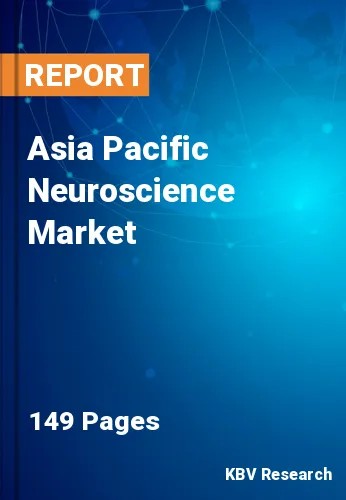The Asia Pacific Neuroscience Market would witness market growth of 6.2% CAGR during the forecast period (2023-2030).
Neuro-microscopy, electrophysiology, neuro-cellular manipulation, whole-brain imaging, and other techniques are the main neurosciences categories offered through tools, supplies, software, and services. A neuro-microscope is designed specifically for brain, spinal cord, and spine surgery. The neuro-microscopy, which has a binocular head with movable eyepieces and foot controls to enable arm mobility, is used to illuminate and magnify the deeper regions of the relevant field. Hospitals, diagnostic centres, research facilities, and academic institutions all employ neuroscience.
The development of neuroscience-related algorithms, ongoing brain mapping research and investigation projects, government-led neuroscience initiatives, and other factors are projected to further fuel the expansion of the market. These elements will encourage product acceptance in this market, increasing revenue creation throughout the projected period. While two-photon microscopy in conjunction with optogenetics-based simulation technology is anticipated to grow quickly as an emerging sector, light and electron microscope neuron imaging techniques have been used for study for longer periods. The market is also expected to develop due to the significantly high number of goods and services available for behaviour study using different animal models.
The percentage of non-communicable neurological disorders in India’s total disability-adjusted life-years (DALYs) has increased from 4.0% in 1990 to 8.2% in 2019. The top neurological disorders causing DALYs in India in 2019 were stroke, headache disorders, epilepsy, cerebral palsy, and encephalitis. In 2019, there was significant heterogeneity in the crude DALY rate of various neurological disorders across different states. The disorders with the highest variation were tetanus, meningitis, and stroke. The growing prevalence of neurological diseases is expected to increase the market for the treatment of such diseases. Moreover, the rising R&D and the advancement of the technologies are expected to increase the adoption for neuro microscopy devices, boosting the market growth in the region.
The China market dominated the Asia Pacific Neuroscience Market by Country in 2022 and would continue to be a dominant market till 2030; thereby, achieving a market value of $4,951.5 million by 2030. The Japan market is registering a CAGR of 5.5% during (2023 - 2030). Additionally, The India market would showcase a CAGR of 6.9% during (2023 - 2030).
Based on Component, the market is segmented into Instruments, Consumables, and Software & Services. Based on Technology, the market is segmented into Brain Imaging, Stereotaxic Surgeries, Neuro-Microscopy, Neuro-Proteomic Analysis, Neuro-Cellular Manipulation, and Others. Based on End User, the market is segmented into Diagnostic Laboratories, Hospitals, and Research & Academic Institute. Based on countries, the market is segmented into China, Japan, India, South Korea, Singapore, Malaysia, and Rest of Asia Pacific.
Free Valuable Insights: The Worldwide Neuroscience Market is Projected to reach USD 64 Billion by 2030, at a CAGR of 5.5%
The market research report covers the analysis of key stakeholders of the market. Key companies profiled in the report include Carl Zeiss AG, Danaher Corporation, Koninklijke Philips N.V., GE HealthCare Technologies, Inc., Terumo Corporation, B. Braun Melsungen AG, Medtronic PLC, Stryker Corporation, Boston Scientific Corporation and Abbott Laboratories
By Component
By Technology
By End User
By Country
Our team of dedicated experts can provide you with attractive expansion opportunities for your business.

